Taxus spp.
The thing about plant geeks is that they can find the most seemingly insignificant bit of greenery to be cool.
The flora that fascinates us would make a layman’s eyes glaze over, while also putting them in a near-fugue state. Exhibit A: me nerding out over a fern’s life cycle at last year’s Super Bowl party.

We link to vendors to help you find relevant products. If you buy from one of our links, we may earn a commission.
But even those with little admiration for Mother Nature would find yews quite fascinating.
It’s like someone took a bunch of qualities that awesome plants are supposed to have and mashed them all together: ornamental beauty, years of mythological significance, utility in weapon-making and medicine, plus a deadly toxicity?!?
Sign me up! Well, maybe not for the poison part…
It’s well worth adding a species or two of Taxus to your garden. Coming in many different sizes, habits, and hardinesses, there’s a plethora of varieties out there just waiting to call your landscape home.
Feel free to read that sentence again, but with Sarah McLachlan’s “Angel” playing in the background for emotional catharsis.
Along with the fascinating history of the Taxus genus, this guide will walk you through proper yew cultivation, how to utilize these plants in the landscape, and how to keep yours free of pests and disease.
Here’s what’s ahead of “yew”:
What You’ll Learn
What Are Yews?
Belonging to the Taxaceae family, the Taxus genus is composed of the handful of evergreen coniferous tree and shrub species that we know as yews.
I’m keeping things vague by saying “handful” because, taxonomically, these plants have been tough for botanists to classify.
For starters, they all look pretty much alike, even among those who study them for a living.
In general, yews have reddish bark, along with dark green, flattened, and lance-shaped leaves about one-half to one-and-a-half inches long, which are arranged in a twisting, near-opposite fashion along the stem.

Their seed cones reach a quarter-inch in length, and are surrounded by scales which morph into bright red, soft arils that appear quite berry-like. Each of these contains a seed.
Several botanical brainiacs have tried their hand at classifying Taxus species over the years.
In 1903, R. K. F. Pilger identified them all as T. baccata or T. baccata subspecies, while R. W. Spjut divided Taxus into 25 different species and over 50 varieties in 2007, based on the slightest of morphological differences.
Nowadays, classifying Taxus according to physical traits, geographic location, and genetic lineages revealed via DNA testing has become the go-to approach for yew identification.
Advancements in technology and taxonomy will reveal more types of yew and continue to clear up confusion as time goes on.
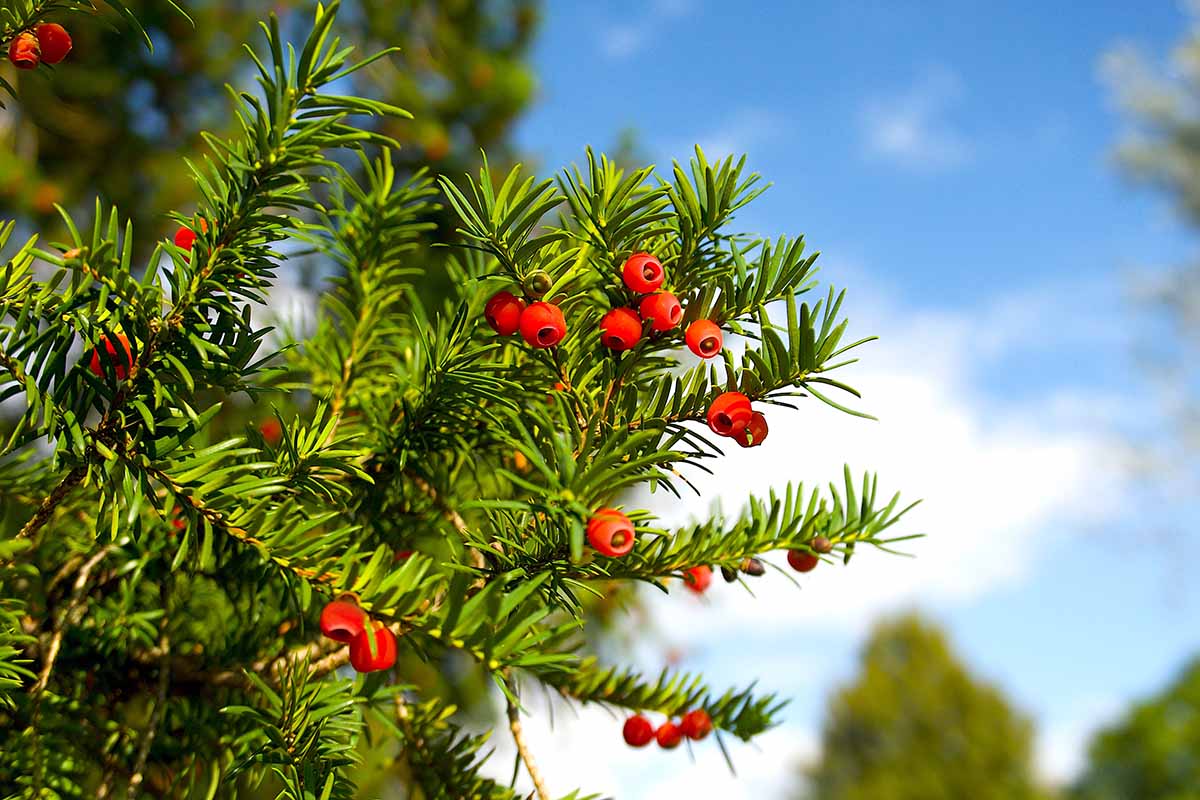
All Taxus species contain taxanes, which are highly poisonous alkaloids. It only takes a minute amount of taxanes to kill humans, dogs, and cattle, while birds and deer can nosh on these plants with no ill effects.
The only parts of a yew’s structure that are free of these dangerous compounds are their bright red arils, which taste quite sweet… forage at your own risk.
Squirrels are known for being adept at removing the seeds – leaving the fruit for the wildlife to enjoy is recommended. Inhaled sawdust and smoke from burned greenery may prove poisonous as well, so treat these plants with caution.
Cultivation and History
Distributed across Africa, Europe, and Asia as well as North and Central America, species of Taxus are pretty widespread, with the genus possessing a collective hardiness within USDA Zones 2 to 10.
Yews span a hot minute of history – Paleotaxus rediviva and Taxus jurassica fossils were discovered in Paleolithic rock layers or strata about 200 and 140 million years old, respectively.
And in more recent history, some particularly elderly trees located in the British Isles today are thought to be thousands of years old!

Yews were associated with Hecate, an ancient Greek goddess of magic and crossroads, and Banbha, a primal Irish warrior goddess.
As long-lived, slow-growing trees that can regenerate a ring of new trunks around the decaying old ones, yew trees were revered by druids as symbols of immortality, death, and rebirth.
These Celtic pagans worshiped at yew-heavy holy sites, which Christians later used as sites for building their churches.
Graveyards near these churches were filled with Taxus trees. Some of these were intentionally planted because it was thought at the time that yews would take in any toxic vapors produced by the rotting bodies that lay in their shallow graves.
The name “Taxus” comes from “taxon,” which is Greek for “bow.”
A fitting name – yew was a high-valued lumber for making longbows, since it possesses that perfect combination of toughness and elasticity for shooting arrows at ridiculously high velocities.
With a longbow made from yew and Hawkeye-esque accuracy, an English archer could put down a fully armored knight from 200 yards away, which really came in handy for repelling invading forces.

In the 1960s, taxanes from the bark of T. brevifolia – i.e. the Pacific yew – were discovered to be anti-tumorous. Subsequent research and development led to the creation of taxol: a naturally-derived drug used in chemotherapy treatments for a variety of different cancers.
The bark of an entire Pacific yew was needed to yield just a single dose of the drug, which was not ecologically sustainable in the slightest.
A method of synthesizing taxol from the more abundant T. baccata was developed, which led to the cell culture method used for taxol production today.
Besides their use in combating medieval soldiers and cancerous tumors, yews are also utilized in ornamental horticulture, with over 400 named cultivars to date.
It’s this aesthetic application that we’ll be focusing on in this guide… because as cool as a bow-making or an anticancer medication-crafting tutorial would be, both are a bit beyond my expertise.
Propagation
Growing a yew from seed isn’t advisable, since germination can take several years.
Propagation from cuttings is faster and it guarantees a genetic clone of the yew you’re propagating from. You could also just transplant a Taxus, if babying a propagule for extended durations ain’t your speed.
From Cuttings
In late summer or early autumn, use a sterilized blade to take four- to six-inch lengths of semi-hardwood cuttings from healthy upright shoots.
Remove the leaves from the lower half of each cutting, and coat the defoliated ends in a rooting hormone, such as this IBA powder from Bonide that’s available from Arbico Organics.
Bonide Powdered Rooting Hormone
Stick the hormone-coated end of each cutting into its own well-draining, four-inch pot filled with sand.
Moisten the sand and place the pots in indirect sunlight indoors, making sure to keep the growing media moist while roots form.
Place saucers or trays under the pots to collect water as it drains, which will prevent water damage on whatever surface you’ve placed them on, and the subsequent kicking-of-oneself. Be sure to empty the saucers or trays immediately after watering.
Test for root growth by giving cuttings a gentle tug. If they resist, you’ll know that roots have developed.
You should repot the cuttings into larger containers as needed to prevent them from becoming root bound, and continue to keep them moist and exposed to indirect light indoors.

Come early spring, provided their root systems are strong, they’ll be ready for hardening off, which will condition them for outdoor survival.
It’s a simple process: leave them outside for 30 to 60 minutes before bringing them inside, then double that exposure time the next day. Continue to add half an hour to an hour of outdoor time on each subsequent day until they can spend a full day outside.
Now it’s transplanting time, baby!
Via Transplanting
To transplant Taxus, you’ll either need rooted yew cuttings that have been hardened off, or a Taxus transplant from a nursery or other vendor. We have some solid recommendations for the latter in the “Species to Select” section below, so don’t miss that!
Once you have your transplantees ready in early spring, choose a fertile, well-draining planting site for each one.
For yews that you wish to grow together as a hedge, space planting sites about 12 to 18 inches apart. If you want your yews to stand out as specimens, be sure to provide a site large enough to accommodate each yew’s mature height and spread.
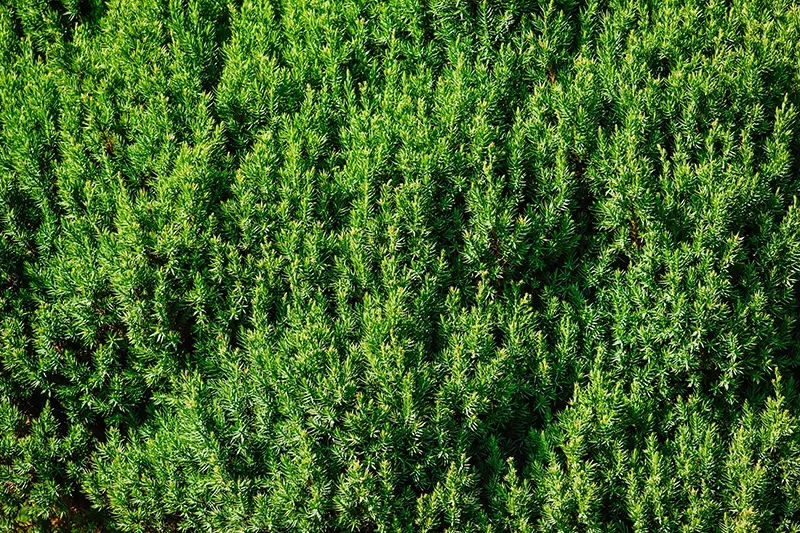
Once your sites are selected, dig holes about the size of the transplants’ root systems. Place the transplants inside – making sure that their crowns are level with the soil surface – and backfill the holes with soil.
Thoroughly water in the transplants, and presto! Your yews have arrived in their permanent home.
How to Grow
A yew is only as awesome as its planting site allows. Give it an optimal growing environment, and it’ll flourish. Otherwise, the aesthetic potential of a Taxus will be bottlenecked by subpar growing conditions.
Climate and Exposure Needs
Different species of Taxus have varying amounts of hardiness. T. canadensis is hardy all the way north to USDA Zone 2, while any region more northerly than Zone 8 would be too cold for T. globosa to bear.
It’s super important to know the temperature requirements of the specific species you’re cultivating.
For more tips, be sure to check our supplemental guide, “How to Manage Winter Damage in Yews.”
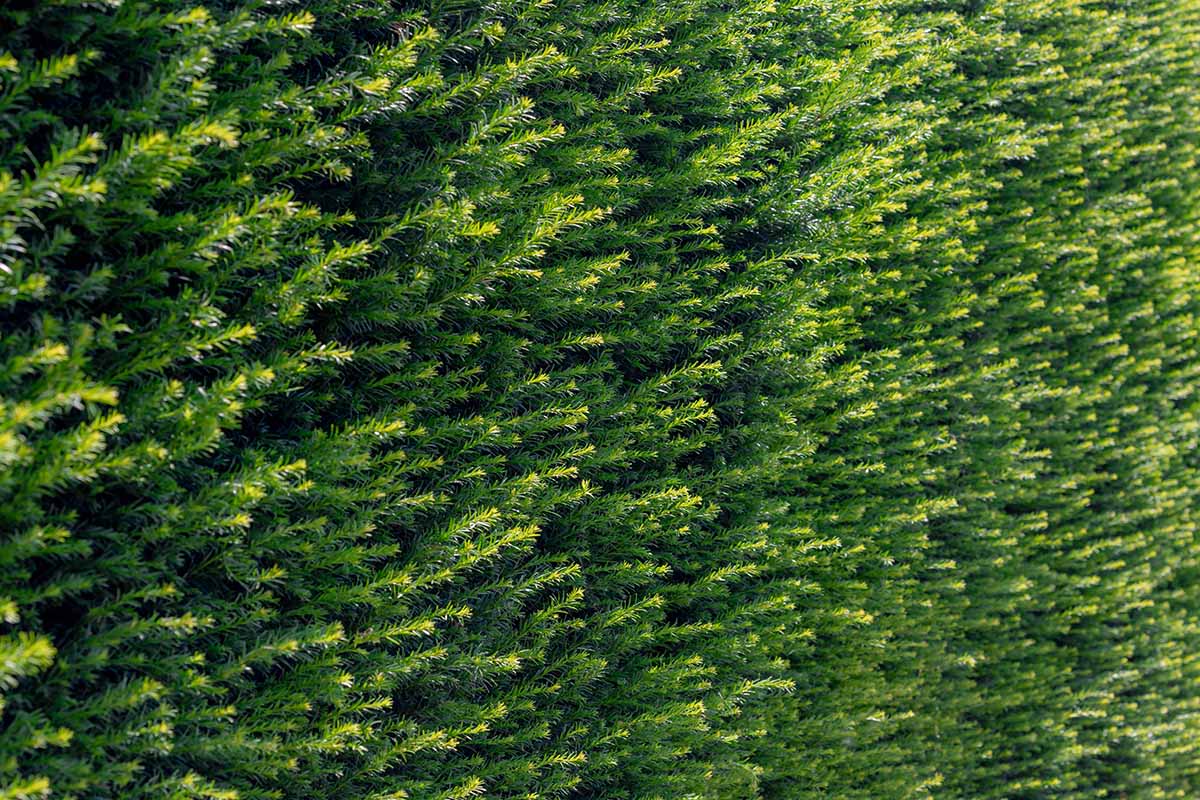
Yews do pretty well in full to partial sun, although sunlight that’s too harsh will dry plants out if they’re not kept properly hydrated. These plants can even tolerate full shade, but growth might become stunted or leggy as a result.
Protect Taxus from strong winds, as leaf desiccation could occur as a result of such exposure.
Soil Needs
One way to kill or severely limit the growth of your yew is to provide inadequate drainage. “Wet feet” spell disaster for Taxus, so ensure that the soil has excellent drainage.
High fertility is another soil quality to shoot for, along with a slightly acidic pH of 6.0 to 6.5.
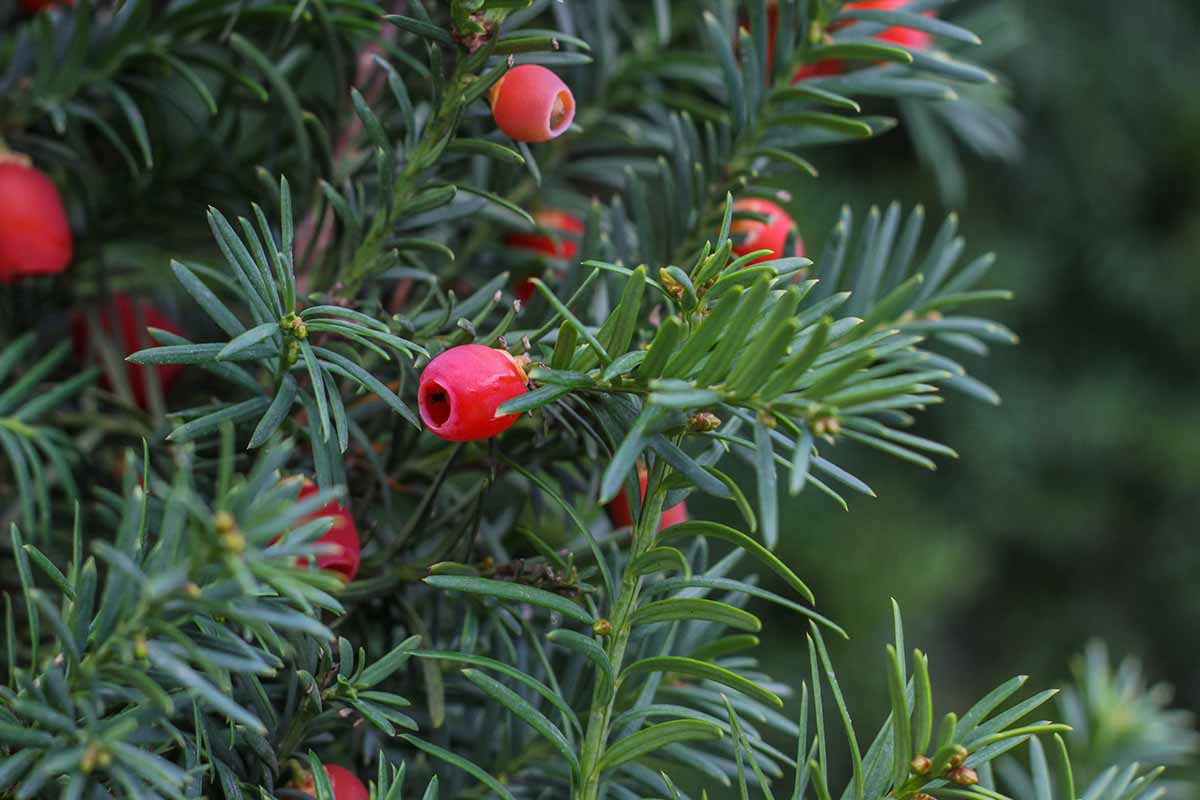
If the above conditions are provided, then the exact soil texture used to get there isn’t super important.
Irrigation and Fertilization Needs
A Taxus sitting in wet, waterlogged soil for even a short stretch of time is at risk of foliar chlorosis, root rot, and death.
Combine that grim reality with a yew’s drought tolerance, and it becomes apparent that too little water is way better than too much. Therefore, irrigate only when the top three inches of soil feel dry once plants are established.
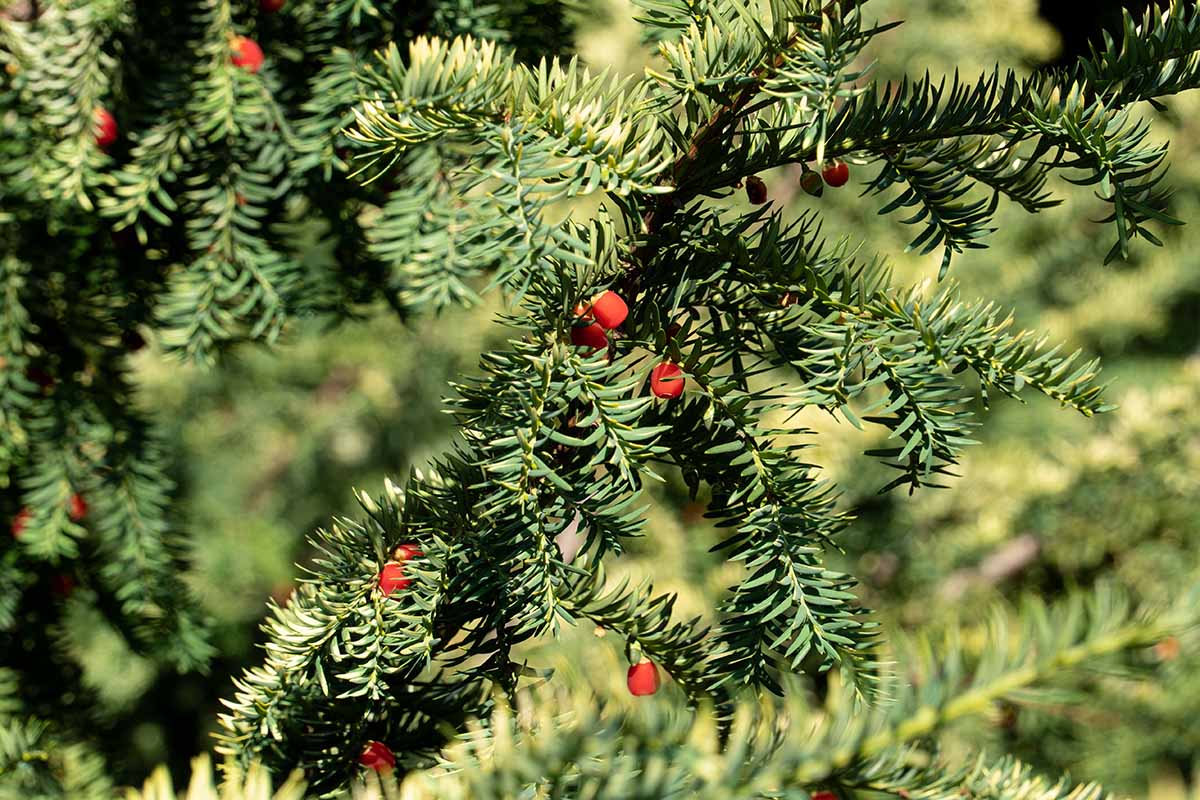
Yews enjoy growing in fertile soil, so a couple inches of well-rotted manure or compost worked into the root zone each spring should keep these guys happy.
These trees grow at a quick pace when they’re young – up to a foot per year – so they will definitely put those soil nutrients to good use!
Growing Tips
- Protect these plants from harsh winds, if at all possible.
- Excellent drainage is paramount for healthy growth and longevity.
- Only water when the top three inches of soil are dry.
Pruning and Maintenance
A decent pruning prior to the appearance of new growth in early spring will both reinvigorate growth and keep your yew in its ideal shape. Make sure to follow the one-third rule: remove no more than one third of the plant in one go.
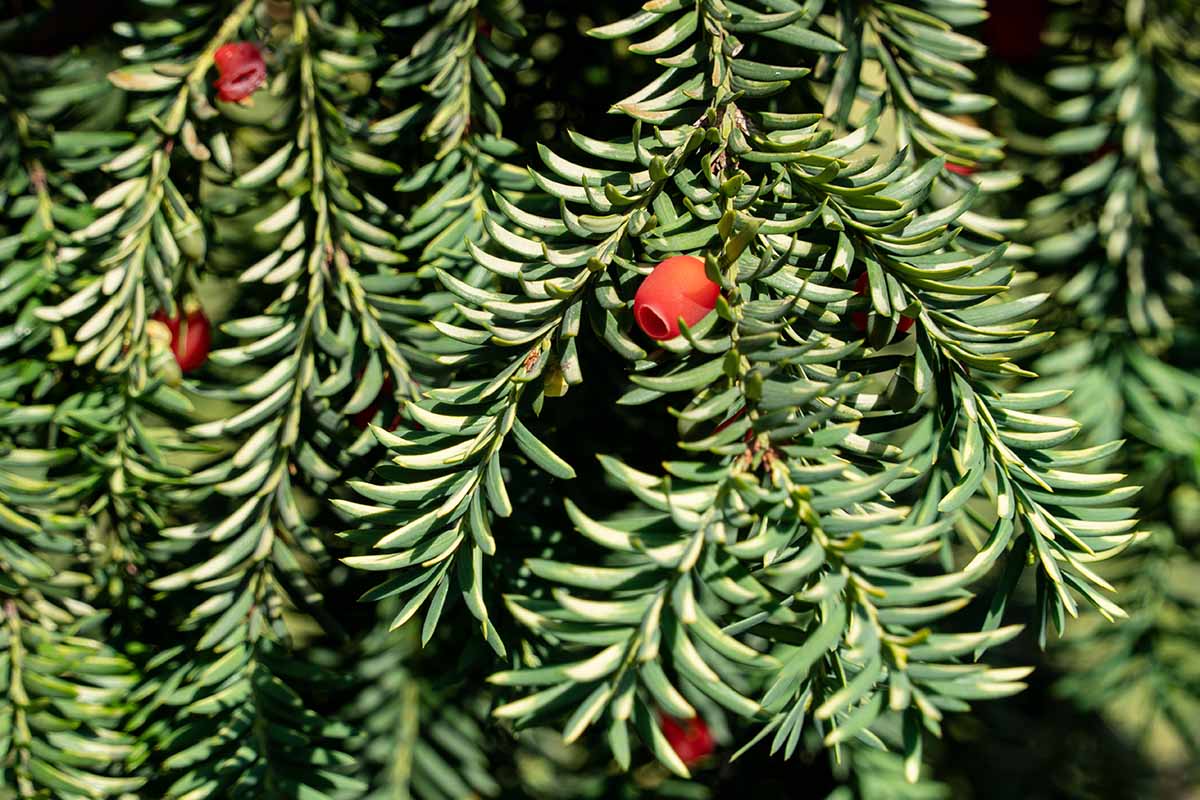
Unless you spot damaged, dead, or diseased branches, that is – you can prune these whenever you happen to see them. Either way, if the slicing and dicing of Taxus ever takes place, make sure it’s done with sterilized blades.
An inch or two of mulch around the root zone will conserve moisture and smother weeds, while also helping to prevent oversaturation of the soil. Space the mulch a couple inches away from the crown to avoid rot.
Species and Cultivars to Select
I’m not gonna lie – these species all flaunt incredibly similar leaves, to the point where selection based on the foliage will leave you more frustrated than the toughest “spot the difference” puzzle.
But when you evaluate Taxus species based on size, habit, or hardiness, their individual merits more clearly reveal themselves.
Let’s have a look at some yews!
Anglo-Japanese
Hardy to USDA Zones 4 to 7, Taxus x media is a hybrid of the English and Japanese varieties, combining the former’s densely-packed branches with the latter’s winter hardiness.
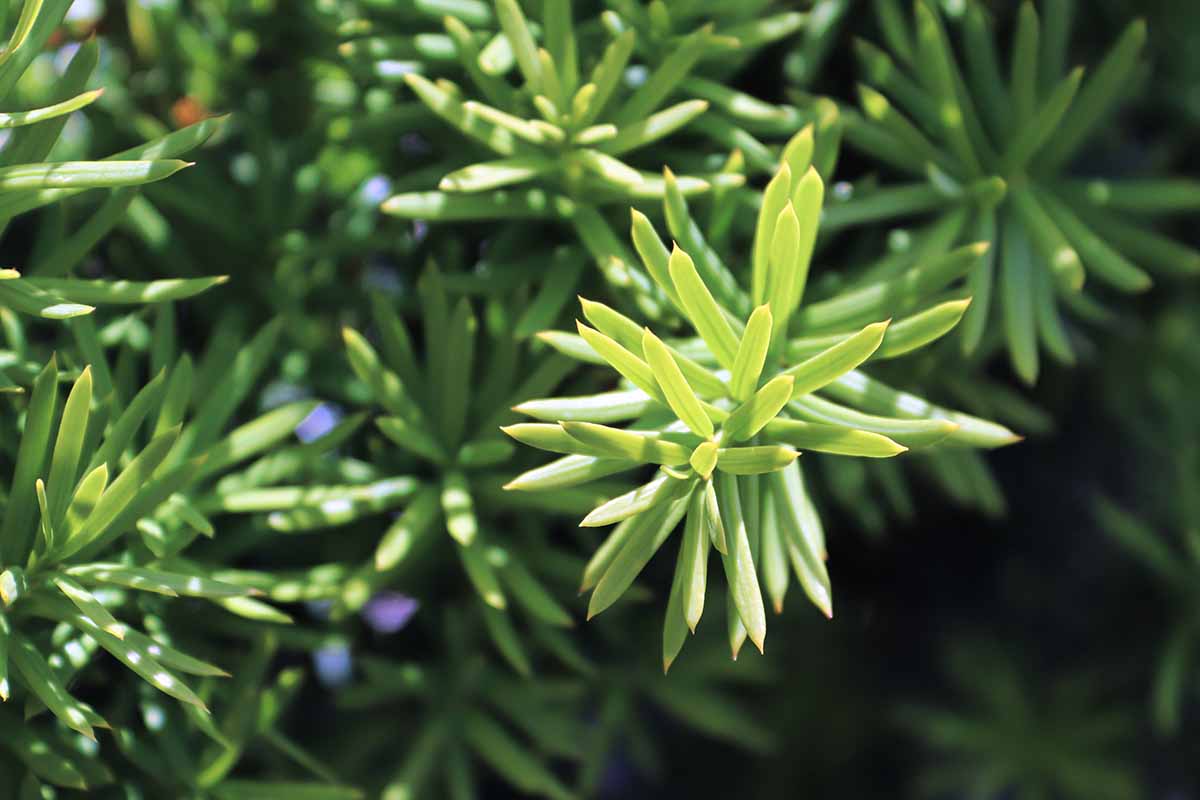
Depending on the cultivar, the Anglo-Japanese yew reaches a mature height of two to 20 feet with a spread of two to 12 feet.
The growth habit of this hybrid is variable as well. ‘Hicksii,’ or Hicks yew, is a columnar variety that typically grows 10 to 12 feet tall with a spread of half that.
Nature Hills Nursery offers ‘Hicksii’ in #3 containers.
‘Densiformis,’ on the other hand, has a more spreading habit, with a mature height of three to four feet and double that in width.
‘Densiformis’ plants are available from FastGrowingTrees.com.
Canadian
Also known as T. canadensis, the Canadian yew is the most cold-hardy Taxus on our list – it’s able to survive as far north as Zone 2! This yew hails from northeastern North America, from Newfoundland as far south as Tennessee.
It’s also pretty small, as it grows three to six feet tall, with a spread that’s often twice as wide as its height.
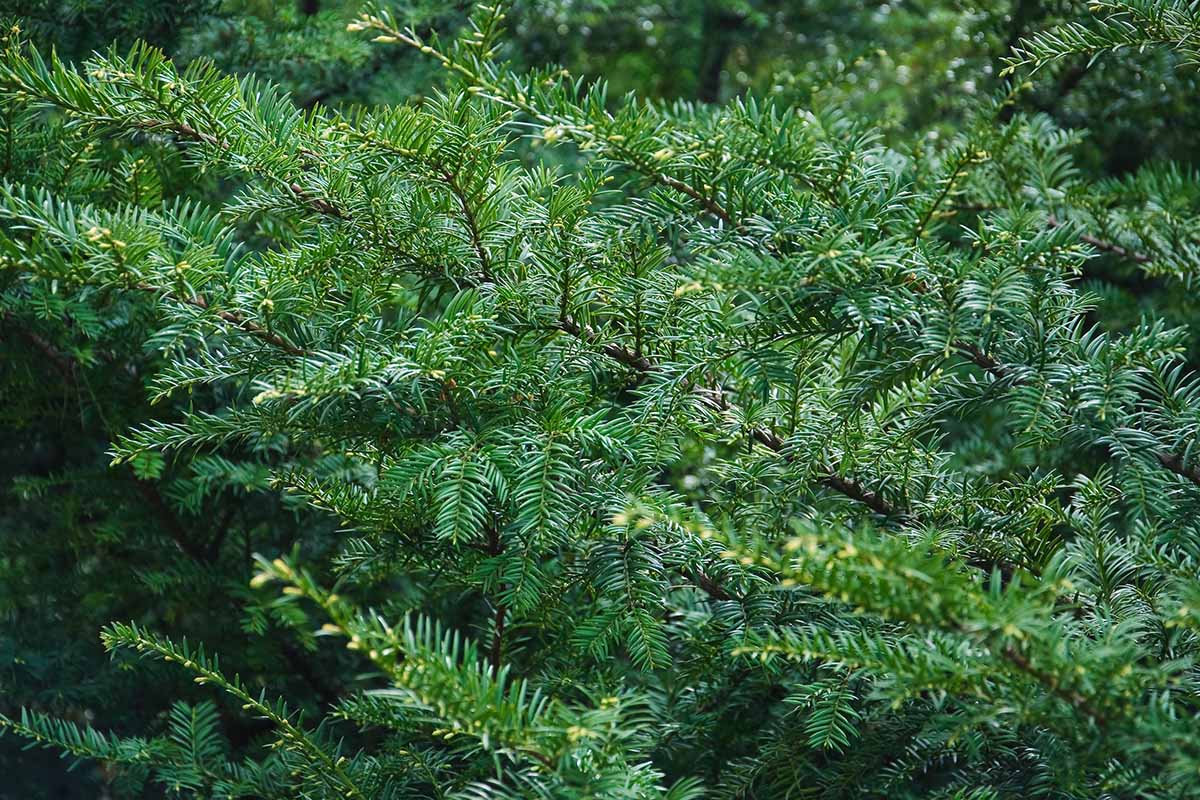
T. canadensis is quite straggly for a yew, and often exhibits a low-spreading and prostrate habit. For a shrub that also doubles as a ground cover, the Canadian yew is perfect!
If droopy branches are a bit too casual for your liking, ‘Stricta’ is a cultivar of this species with strictly upright greenery.
English
Native to Europe, northern Africa, and southwestern Asia, T. baccata typically grows 30 to 60 feet tall and 15 to 25 feet wide at maturity.
Hardy in Zones 5 to 7, the English yew is known for especially dense branching, and typically has a wide-spreading habit, although there are a plethora of different shapes offered by various cultivars.

It’s ideal for use as a shade tree or a screening hedge, since the tightly-packed greenery of this plant makes it tough for sunlight or prying eyes to poke their way through.
And although not as dense a canvas as, say, a boxwood, T. baccata is a fine plant for topiary work.
The standard species can be purchased from Nature Hills Nursery.
There are also a couple of interesting cultivars to note. Growing up to 30 feet high and eight feet wide, ‘Fastigiata’ – also known as the Irish yew – has all of its branches pointing straight up, making it a skinny addition to tight spaces.
But don’t confuse it with the cultivar of the same name that is a type of upright Japanese plum yew, or Cephalotaxus harringtonia.
‘Repens Aurea,’ on the other hand, reaches a mature size of 14 inches tall and 4 feet wide, and flaunts golden-green foliage.
Japanese
A versatile plant, T. cuspidata traces its origins to Japan, Korea, and the part of northeastern China once known as Manchuria, and is hardy in Zones 4 to 7.
Reaching fully grown heights of 10 to 40 feet, the Japanese yew usually spreads wider than it grows tall, and has a more irregular habit and more open branching than T. baccata.
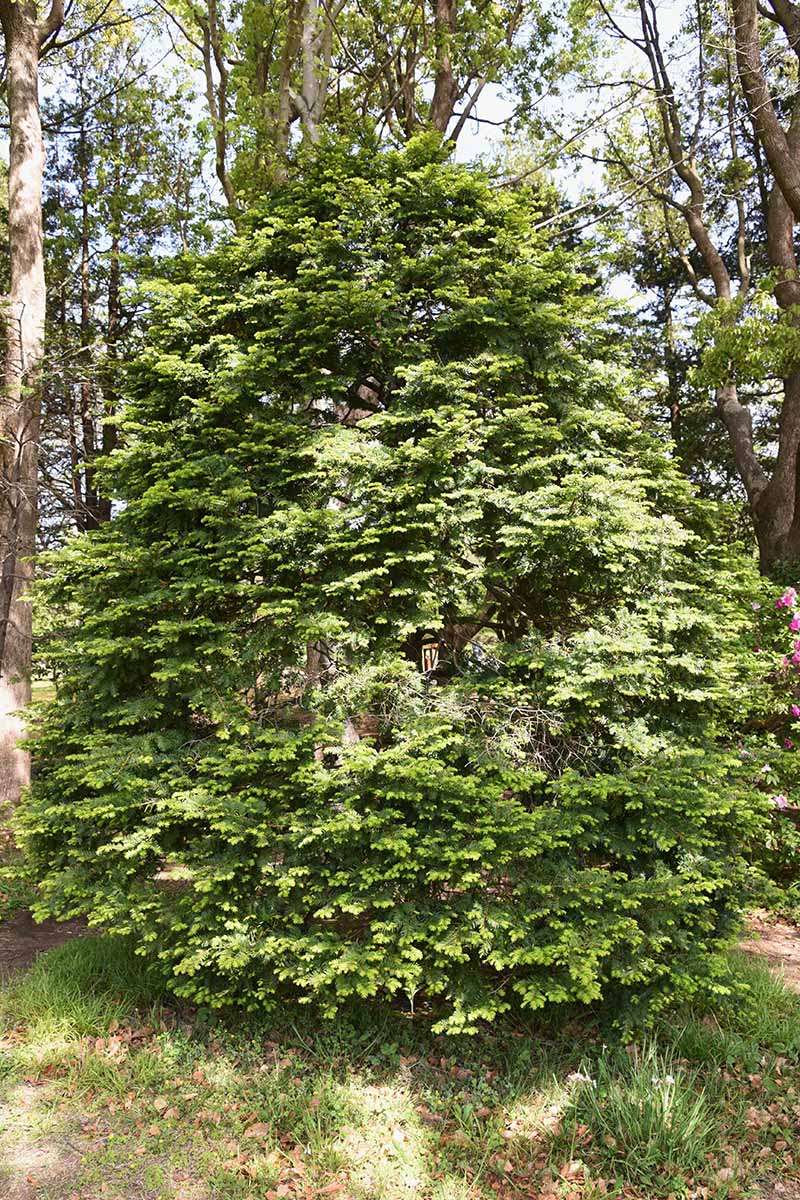
Hedges, bonsai, foundation plantings – the Japanese yew can fill all those roles and more.
‘Golden Treasure’ is a bright gold, compact cultivar that shines best in full sun, while ‘Capitata’ reaches 40 to 50 feet in a stereotypically tree-like pyramidal form.
Managing Pests and Disease
Dealing with pests and pathogens is not the most fun part of growing plants, but it’s one of the most essential.
Thankfully, the risk of many of these infestations and infections can be reduced simply by caring for your Taxus properly, since health and vigor plays an important role in staving off problems and improving resistance.
Herbivores
Birds consume yew berries, and woodpeckers like yellow-bellied sapsuckers may occasionally cause damage if branches are girdled by the holes they create.
But let’s focus here on a common hoofed enemy of gardeners everywhere, which is none other than the…
Deer
“But they’re so cute!” you might protest. You know what’s not cute, though? Having the bottom five feet of your Taxus defoliated after a deer munch-a-thon.
When winter strikes, hungry deer look for anything green, which includes yews.
And while consuming a small amount of leaves would be enough to kill you and me, deer stomachs can’t quite digest the taxanes, expelling them and allowing the animals to make a full smorgasbord out of an otherwise toxic meal.
Spraying plants with deer repellant or putting up deer fencing around your property are your best bets.

Six-pound tubs of granular deer repellent are sold by Enviro Pro on Amazon, and we have a DIY deer fencing guide for ya right here!
Insects
In addition to the physical damage they cause, creepy-crawly pests also tend to carry pathogens from plant to plant, so proper pest management is key. It’ll save you a lot of pain on the disease front!
Black Vine Weevils
Otiorhynchus sulcatus is also known as the taxus weevil, which signifies its status as a mortal enemy of the yew.
Both the shiny black, hard-shelled adults and the white, C-shaped, legless grubs feed on yews.
The former leave half-oval notches on foliage – which is less damaging and more indicative of an infestation – while the latter feed on roots and lower stems, resulting in reduced nutrient flow and eventual plant death.
In late spring, female adults lay up to 500 eggs in the soil near plant bases, which hatch in midsummer. Larvae emerge and feed in summer, fall, and in the spring following an overwintering period in the soil.
Adults will also occasionally overwinter in the soil but it’s not as common, and these pests usually produce only a single generation per year.
Spraying plants with neem oil can kill the adults, while grubs are best taken out with a soil drench of beneficial nematodes such as Steinernema carpocapsae.
Natria sells 24-ounce bottles of ready-to-spray neem oil on Amazon, and Arbico Organics offers the aforementioned nematodes in copious amounts of larvae-slaying awesomeness.
Taxus Bud Mites
Cecidophyopsis psilaspis is an occasional yet serious pest of yews, whose summer and fall feeding distorts shoots and foliage.
These deep red, microscopic pests infest branch buds via wind migration in summer, with up to 1,000 mites fitting on a single bud. The adults overwinter between bud scales, and thus get a head start on distorting bud growth come spring.
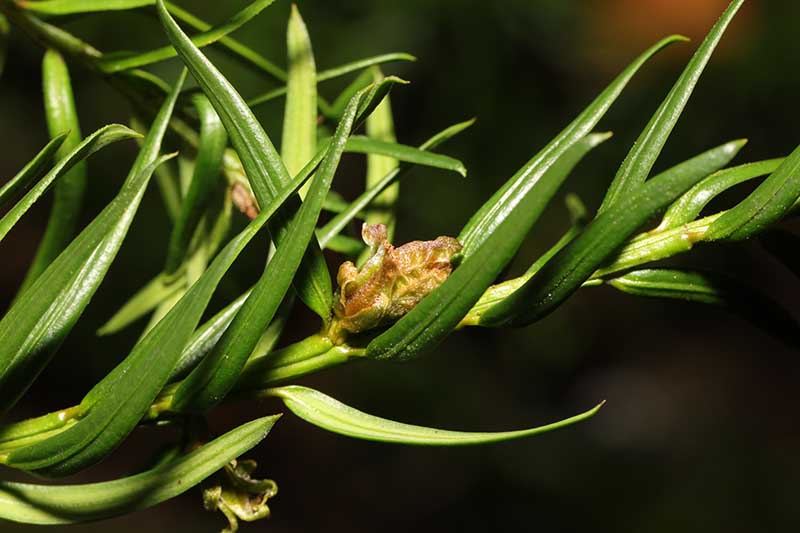
Symptoms of an infestation include needle and shoot distortion. Applying horticultural oil or insecticidal soap to plants about a week before bud break will kill any overwintering adults, should your plant be prone to infestation.
Given the tiny size of these pests, enlisting the help of a pest management specialist or extension agent for a diagnosis would be wise.
Taxus Mealybugs
The most conspicuous stage of the life cycle of Dysmicoccus wistariae is adulthood among the females, which are a fifth to a third of an inch long, with red, oval-shaped, wingless, segmented bodies, and coated with a white wax.
Males are smaller, white, and dual-winged, while nymphs are small, smooth, and yellow to brown in color.
The nymphs overwinter in the bark, and emerge in spring to feed, usually in the crotches of twigs. This feeding fuels their transformation into adults, and continues until just before the arrival of winter.
In addition to excreting honeydew – which can attract black sooty mold – taxus mealybug feeding causes chlorosis, leaf decline, dieback, and overall poor growth.
Removing white, cottony masses of eggs and pruning away highly-infested branches will help to control populations and prevent further damage. The pests can also be removed by hand with cotton swabs dipped in isopropyl alcohol.
Additionally, you can introduce beneficial insects such as ladybugs, lacewings, syrphid flies, and parasitic wasps as a form of biological warfare. For a selection of mealybug-slaying bugs, check out Arbico Organics.
Yew Scale
Oval-shaped, brown-hued, and up to a fifth of an inch long, adult Parthenolecanium pomeranicum can be found sucking sap and excreting honeydew on the foliage and branches of infected Taxus in early summer.
They lay eggs, which nymphs emerge from in late summer to feed alongside their parents.
Small populations aren’t a cause for concern, but heavier infestations can strain plants and negatively impact growth. Additionally, yew scale excrete honeydew, which impacts aesthetics and provides ideal conditions for sooty mold to develop.
Swabs of isopropyl alcohol, springtime sprays of horticultural oil, and the introduction of natural predators such as parasitic wasps and ladybugs will help keep yew scale under control. Prune away any heavily infested branches.
Disease
One of the simplest and most effective ways of preventing disease spread is to be mindful of sanitary practices in the garden.
This means sanitizing your garden tools in between different plantings, planting disease-free stock, and working with pathogen-free soils.
Phytophthora Crown and Root Rot
Caused by several different species of Phytophthora oomycetes, aka water molds, Phytophthora crown and root rot is a particularly tough disease to manage.
Living in the nearby soil, the causal pathogens produce spores that can travel to vulnerable roots via waterlogged soils.
When a yew is infected, the fine roots are the first to die, followed by the larger ones, and then the crown finally perishes.
Once the crown is afflicted, aboveground symptoms start – leaves become stunted, wilted, chlorotic, and necrotic, while the branches themselves begin to die back.
The water molds thrive in wet and low-oxygen conditions, both of which are provided by waterlogged soils. Upon arrival, these pathogens can persist in the soil for years.
Prevention is paramount: ensure that your soil is well-draining. Infected plants must be removed and destroyed, and contaminated soil should be avoided until you can sterilize it.
Do this by choosing the warmest time of year to water infected soil deeply, then lay a clear tarp over the contaminated soil, with the goal of maintaining daily temperatures of 110 to 125°F in the top six inches of soil for four to six weeks.
The temperature should be checked frequently with a thermometer. Keep the tarp in place with rocks or bricks, and add an extra week or two of solarization if wind, cold, and/or cloudy weather strikes, bringing the soil temperature lower than what’s necessary.
Root Rot
The physiological condition known as root rot also does not have to be pathogenic – although it can bring about conditions that certain pathogens love – and “wet feet” can pose a significant threat to a yew’s health.
When the roots sit in oversaturated soil or standing water, they suffocate from reduced oxygen. Even without any pathogens present, this is enough to lead to reduced growth, leaf chlorosis, foliar browning, dieback, and death.
Providing good soil drainage is the best way to prevent and care for a yew suffering from “wet feet.”
If the specimen is too far gone, you’ll have to remove it and replant. If ample soil drainage isn’t possible, replace the yew with a more water-tolerant plant such as viburnum, arborvitae, or deciduous holly (Ilex decidua).
Best Uses
Yews are botanical polymaths: masters in many different areas.
For starters, they can stand out on their own as specimens, bonsai, or topiary plantings. They can also play a supporting role to more colorful plantings, as their dark green foliage often provides the perfect backdrop.
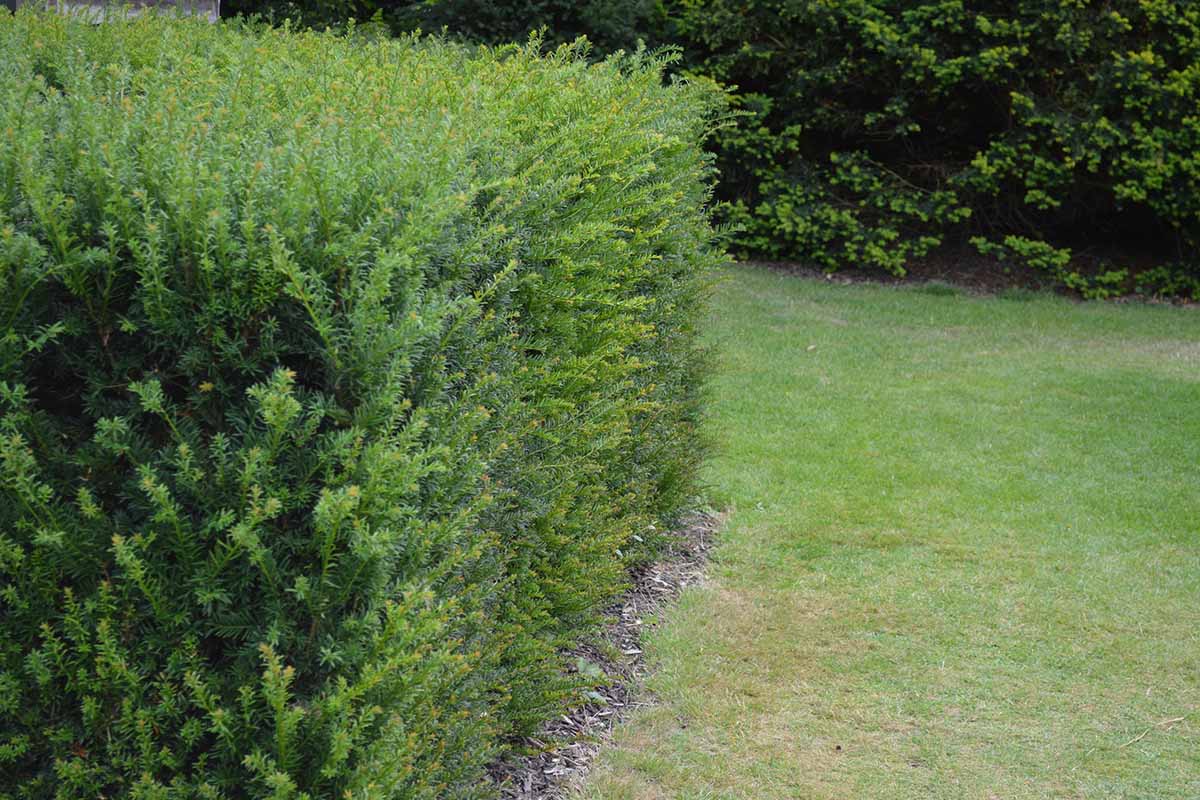
Around the home, Taxus can gracefully line the structure’s foundation, designate property boundaries, or simply provide some privacy as a screening hedge.
Within each of these roles, a multitude of cultivars provide seemingly endless options in terms of size and growth habit.
Honestly, the sky’s the limit – along with your budget and imagination – for what you can do with one of these bad boys!
Quick Reference Growing Guide
| Plant Type: | Evergreen landscape tree or woody shrub | Foliage Color: | Green (red fruit) |
| Native to: | Africa, Asia, Central America, Europe, North America, depending on species | Water Needs: | Moderate |
| Hardiness (USDA Zone): | 2-10, depending on species | Maintenance: | Moderate |
| Bloom Time / Season: | Spring | Tolerance: | Drought, shade |
| Exposure: | Full sun to partial shade | Soil Type: | Sandy loam, fertile |
| Time to Maturity: | 10-20 years | Soil pH: | 6.0-6.5 |
| Spacing: | 12-18 inches (hedging), width of mature spread (specimens) | Soil Drainage: | Well-draining |
| Planting Depth: | Depth of root system (transplants) | Attracts: | Birds, deer |
| Height: | 3-60 feet, depending on species | Uses: | Accent, bonsai, border, foundation planting, hedge, specimen, topiary |
| Spread: | 6-40 feet, depending on species | Family: | Taxaceae |
| Growth Rate: | Fast (juvenile), slow (mature) | Genus: | Taxus |
| Common Pests and Diseases: | Black vine weevils, bud mites, mealybugs, scale; Phytophthora crown and root rot | Species: | Baccata, canadensis, cuspidata, x media |
Put a Yew in Your Gardening Queue
I’m sure there are many incredible plants that you have in mind for future planting, but the yew absolutely deserves to be at the top of that list. There must be a spot somewhere in your garden where one can shine.
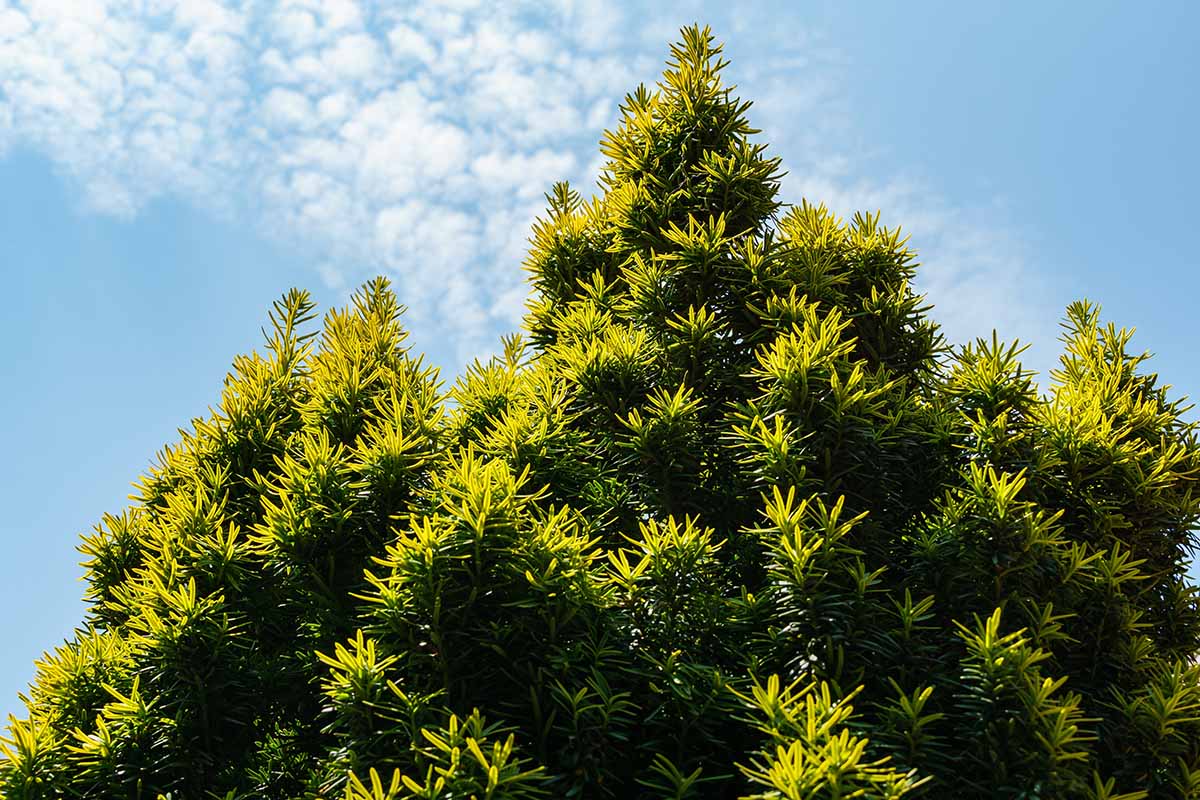
Hopefully, this guide has provided some helpful guidance on the Taxus-growing process. Don’t be afraid to deviate from these recommendations if a particular species or variety has slightly different care requirements.
Questions? Remarks? We love to see it – head to the comments section to share your thoughts!
Intrigued by evergreen shrubs? Have a read of these guides next:
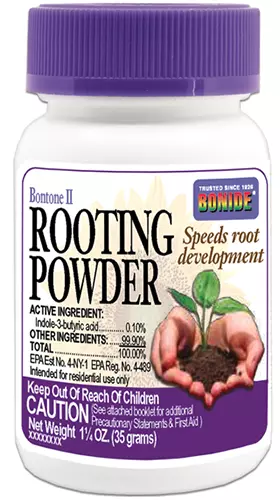

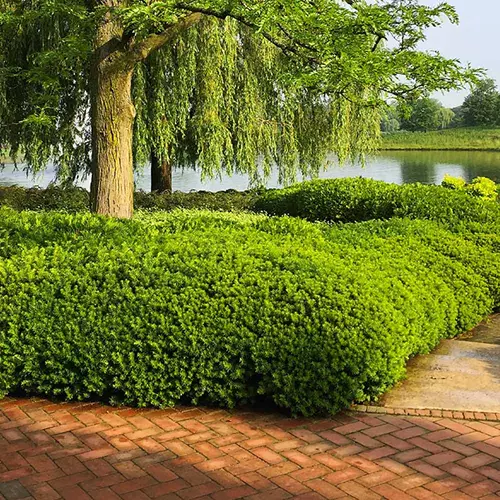

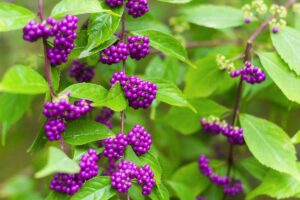
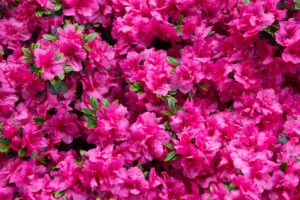
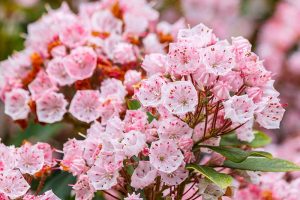
getting a lot of yellow and some brown on my yew shrub. It’s around 8 yrs old… i just watered it a couple of gallons as it has been very dry here. I put some miracle grow in water. think i’ll go out and rake needles from under the plant
Hi Mary, sorry your yew is going through that! Even when yews aren’t drought-stressed, some needle drop is normal, as three-year-old needles tend to yellow/brown and drop in spring to early summer.
But it sounds like you’re doing the right things – you’re watering and fertilizing in case of drought and deficiency, and you’re raking up the dropped needles, regardless of the cause. Keep up with your yew care, and feel free let us know how it plays out!